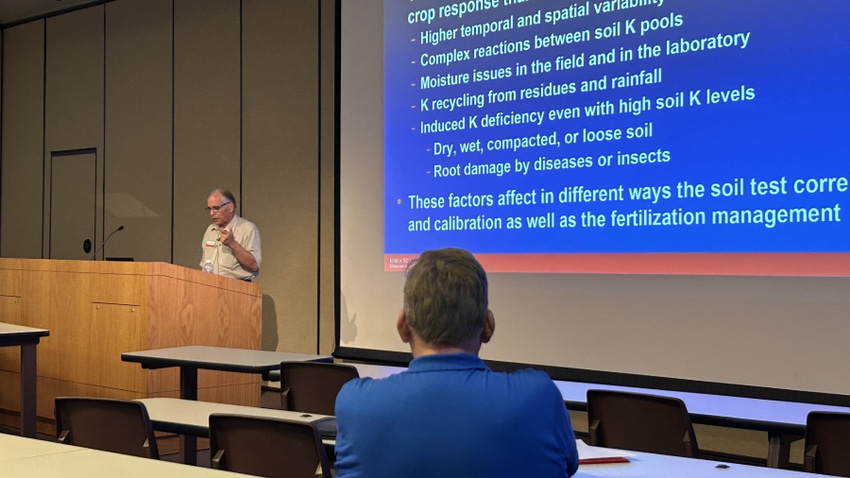
Yellowing and curling leaves slowly take over fields, inching from soybean plant to soybean plant. The culprit: possibly potassium deficiency.
To solve this dilemma for these potassium-deficient crops, it all comes down to the soil conditions. Without proper moisture in the soil, it can make it difficult for crops to extract potassium from the soil, even if the levels are adequate.
Antonio Mallarino, Iowa State University agronomy and nutrient management Extension specialist, addressed the frustrations of potassium deficiencies considering the recent drought during the 2023 University of Nebraska 4Rs Management Field Day, held last summer at the Eastern Nebraska Research, Extension and Education Center near Mead.
Mallarino and his team are constantly researching for more accurate testing to diagnose these potassium shortages in fields.
“There are plenty of tests for phosphorus and nitrogen all over the world, but only five or six for potassium,” Mallarino said.
Causes of deficiency
A telltale sign that fields are deficient in potassium is if the end rows do not show the yellowing and curling of leaves, but further in the field, there is evidence of a deficiency. Mallarino saw most potassium deficiencies in no-till fields and ridge tillage. But even with this management practice, it is possible to combat and prevent potassium deficiencies for years to come.
The drought that a majority of the Midwest went through during May and June made potassium deficiencies more prevalent. If farmers took a soil sample, there is a good chance that results came back showing that there was enough potassium in the topsoil for uptake.
However, for potassium to be absorbed through the soil, there needs to be enough moisture for the roots to transport the nutrients. These tests pick up on nonexchangeable potassium, which is not readily available for the crops to use.
“Potassium deficiencies can also happen with compacted or variable soil, or when there is root damage by diseases or insects,” Mallarino said. “All these factors effect potassium uptake in different ways.”
Action plan
Once potassium deficiency has set in, there is not a lot farmers can do to combat the problem. However, the good news is that if the deficiency is not extreme, then most plants will recover with resumed regular rainfall. Mallarino said that new leaves will most likely not show the yellowing of potassium deficiency, if the drought is not too extreme.
To prevent potassium deficiency for future yields, it is important to test the soil at the right time and look at the economic trade-off of applying more potassium.
“Essentially after November or December in Iowa, there is not much [potassium] left,” Mallarino said. “The soil leached out anywhere from 80 to 100 pounds of potassium.”
Mallarino said the best time to test soil for potassium deficiency is either postharvest or in March, while there is still plenty of moisture in the soil. However, before applying more potassium to fields, it is important to look at the cost trade-off for application.
“Look at trends over time and reward based on yield to see if there is some value,” Mallarino said. “If it does not make sense to apply more, just ignore it.”
If farmers decide to apply more potassium to the soil, he recommended that the application be delivered to soybeans through foliar fertilization with fluid fertilizer containing potassium. However, it is important to not apply more than 12 pounds of potassium per acre, so the foliage is not damaged.
While Mallarino’s area of expertise covers Iowa, he said that the eastern side of Nebraska can follow these recommendations as well. But he urged farmers to consult with a local Extension agent to follow through with the most effective plan.
To find contact information for your local Extension agent, visit epd.unl.edu.
About the Author(s)
You May Also Like






